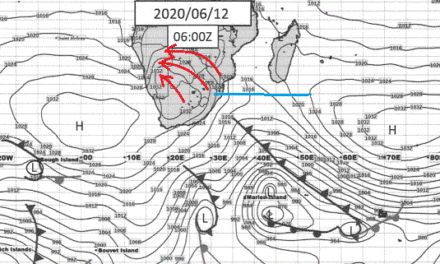
Weather 13 March 2015
 What Happened
What Happened
The most prominent feature on Sea Surface Temperature maps is that the wide expanse of warmer water between southern Africa and South America has now returned to normal. Only a small isolated patch of warmer water still sits off the South American coast but by all indications, it is also receding.
Restoring sea surface temperatures closer to the African continent to normal means the South Atlantic high pressure cell will also slowly revert to normal. With the presence of warmer water, this high pressure cell tended to shift northward and disperse over a much wider area of the ocean despite the relative weakness of its core. It can reasonably expected that over the next semester through the austral winter, the South Atlantic high pressure cell will be fully restored in intensity and location.
Sea surface temperatures over the eastern Pacific are still slightly above normal indicating a weak El Nino while the Southern Oscillation Index maintained by the Australian Bureau of Meteorology is marginally negative. However, it has moved from deep negative territory during January and February to just an inch into positive territory last week. This strong upward phase in the index is indicative of improved (normalised) atmospheric conditions, and is a tentative indicator that the Namibian rain season may improve during March and April.
The synoptic pattern remained conventional during the week. A high pressure system dominates conditions over eastern Africa while low pressure is the norm over Angola, Namibia, Western Zambia and Botswana. In the space between the high pressure over the eastern half of the sub-continent, and the South Atlantic high pressure cell, a well-demarcated trough has developed over the previous weekend and remained in situ during this week. It created a so-called convergence line where high pressure meets low pressure with the centre of this line displaced towards the south, i.e. from around Swakopmund to Noordoewer. North-east of this line is where all the rain activity took place while the southern Namib remained hot and dry.
Although the trough weakened during this week, it is still present and while it is unreasonable to expect a repeat of the weekend’s rainfall, it still holds the promise of isolated thundershowers where the right mix of conditions develop. But because the overall synoptic pattern indicates a continuation of high pressure control in the south-east (South Africa) and low pressure in the north-west (Angola), the mechanism that advects tropical moisture, remains active.
The position and the strength of this mechanism are determined by the relative proximity of the South Atlantic high pressure cell, as well as its intensity. It is offset by the relative strength of the continental low pressure anti-cyclonic circulation, which in turn, is driven by the high pressure control over the eastern half of the continent. All the elements of this dynamic system are in place, so some moisture will continue to penetrate Namibian airspace. The actual precipitation will be determined more by local conditions.
What’s Coming
Clear and sunny conditions are indicated for most of the country for the weekend. The only exception is the south-eastern corner, East Karas so to speak, where vestiges of moisture remain in the middle layers between 15,000 and 30,000 feet. This may produce scattered showers over a fairly large area more or less from Mata Mata across the eastern half of Karas right up to the Orange River Valley.
The (low pressure) trough remains in place from south-western Angola across Namibia into southern Botswana and northern South Africa. Over the weekend and into Monday, it is weaker but it is still there. By Tuesday next week, it has resumed some dominance and there is again a reasonable chance for light showers all the way from the Kaokoveld across the interior above the escarpment and into the Kalahari. However, conditions are not that positive so any individual fall that exceeds 15mm must be seen as a blessing.
As the South Atlantic high slips past the Cape, the wind in the southern Namib will be prominent southerly, slowly veering east towards the end of the weekend.











































